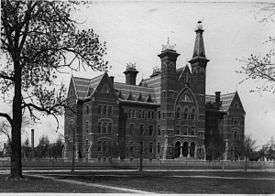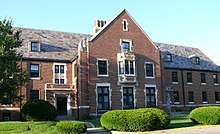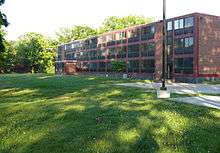Rose-Hulman Institute of Technology
 | |
| Motto | Labor et scientia (Latin) |
|---|---|
Motto in English | Labor and Knowledge |
| Type | Private coeducational |
| Established | 1874 |
| Endowment | $185 million[1] |
| President | James C. Conwell |
Academic staff | 182[2] |
| Undergraduates | 2,233[3] |
| Postgraduates | 71[3] |
| Location |
5500 Wabash Avenue Terre Haute, IN 47803 (812) 877-1511 |
| Campus | Suburban: 200-acre (0.3 sq mi; 80.9 ha)[3] |
| Colors | Old Rose and White |
| Athletics | NCAA Division III – HCAC[4] |
| Nickname | Fightin' Engineers |
| Affiliations |
AITU MUPEC |
| Sports | 20 varsity teams |
| Mascot | Rosie the Elephant |
| Website | www.rose-hulman.edu |
|
| |
Rose–Hulman Institute of Technology (abbreviated RHIT), formerly Rose Polytechnic Institute, is a small private college specializing in teaching engineering, mathematics and science. Its 1,300-acre (2.0 sq mi; 526.1 ha) campus is located in Terre Haute, Indiana.
History

Founding
Founder Chauncey Rose, along with nine friends, created the Terre Haute School of Industrial Science in 1874 to provide technical training after encountering difficulties in local engineer availability during construction of his railroads. Mr. Rose donated the land on 13th and Locust St. and the majority of the funds needed to start the new school. A year later, the cornerstone of the new institution was laid and the name was changed to Rose Polytechnic Institute despite the objections of the president of the board of managers and chief benefactor, Mr. Rose. The original campus was a single building, with no dormitories or recreational facilities.[5][6]
The first class of 48 students entered in 1883, chosen from 58 applicants. Of the 48 students, all were male, and 37 came from Indiana. All but four students chose to major in Mechanical Engineering with Civil Engineering and Chemistry the only other majors. Nearly half of the original students would eventually quit their studies before graduation for a number of reasons, including poor grades or conduct.[7] The first president was Charles O. Thompson, who modeled the education of Rose Poly after eastern institutions. Rose Poly was thus founded as the first private engineering college west of the Alleghenies.[6]
During the beginning years of the school, money was a major concern. A lot of faculty and staff were forced to take pay cuts in order to stay at the institution.[6]
In 1889 the school awarded what it considers to be the first Chemical Engineering degree in the country.[8]
Relocation
In 1917, the school, having grown to more than 300 students, moved from 13th and Locust St. (on which now sits Chauncey Rose Middle School) to a new site consisting of 123 acres (0.50 km2) of farm land on U.S. 40 donated by the Hulman family of Terre Haute. The cornerstone of the new campus was laid in 1922. The new campus consisted of an academic building and the institute's first dorm, Deming Hall, which is still used by freshman today.
Early life at Rose consisted of social fraternities, athletics, and the occasional "high jinks." A popular "high jinks" involved the sophomore class inviting the freshmen class to a baseball game but were told to "leave their pipes with the nurse." The freshmen would produce the pipes at a specific time and a brawl would ensue.[6]
War years
During World War I Rose Poly trained students in technical subjects like vehicle maintenance, and created a ROTC Engineer unit. During World War II the ROTC unit was replaced with an Army Specialized Training Unit and students could enter and graduate after every quarter in order to support the war effort. This enrollment schedule continued through the post-war years until 1951. A tank was located behind the north sides of Moench Hall and Myers Hall as a reminder of Rose Poly's war contributions, but has recently been moved from the campus for reasons unknown.[9]
1960s–1970s
In recognition of the Hulman family's significant contributions and continued financial support, Rose Polytechnic was renamed Rose–Hulman Institute of Technology in 1971.[6]
During the 1960s and 70s, growth accelerated under president John A. Logan. Five new residence halls, a new student union, library, and a student recreation center were all constructed between 1963 and 1976. Permission was sought and received to increase the student population to 1000.[10]
The quarterly cryptology journal Cryptologia was founded and published at RHIT from 1977 to 1995, at which time it was moved[11] to the United States Military Academy.
1990s onwards
For most of its history, Rose–Hulman was a men's-only institution. It voted to become coeducational in 1991, with the first full-time women students starting in 1995.[12] Also in 1995, the college required all incoming freshmen to purchase laptop computers, becoming one of the first schools to do so.
In the decade following 1995, Rose–Hulman's growth was aided by a major fundraising campaign called "Vision to be the Best." Originally a $100 million campaign over ten years, it met its goal in half the time. The goal was extended to $200 million, and by the end of the campaign in June 2004, over $250 million had been raised. In 2002, Hatfield Hall, a state-of-the-art theater and alumni center was opened. Five years earlier Shook Field House was replaced with the $20 million Sports and Recreation Center, which is a major reason that the National Football League's Indianapolis Colts used the campus for their summer training camp from 1999–2010.
After the 2004 retirement of institute president Samuel Hulbert, who had led the school since 1976, the college faced a leadership crisis. Soon after John J. Midgley arrived as the new president, rumors of conflict between Midgley and the administration started to circulate. Students, some wearing T-shirts proclaiming "Hit the Road Jack," held a rally calling for Midgley's resignation.[13] Midgley resigned as president of the institute on June 11, 2005, less than a year into his presidency, after the faculty,[14] staff, and Student Government Association approved votes of no confidence. During the succeeding academic year, Robert Bright, the Chairman of the Board of Trustees, served as interim chief executive officer.
At a press conference on March 17, 2006, Bright named Gerald Jakubowski, Vice President and Professor of Engineering at Arizona State University, as the thirteenth president of the Institute. Jakubowski took over effective July 1, 2006.[15] On February 23, 2009, Jakubowski announced that he would be resigning from the position of president, effective June 30.[16][17]
On June 11, 2009, the college announced that the Board of Trustees had elected Matt Branam to serve as interim president.[18] On December 4, 2009, the Board elected Branam as permanent president. In April 2012, Branam suffered a heart attack and was rushed to a hospital where he died shortly afterward.[19] The cabinet subsequently selected Robert A. Coons as the Institute’s Interim President.
On March 4, 2013, the Rose-Hulman Board of Trustees named James C. Conwell as the institute's 15th president starting May 1, 2013.[20]
In 2017, the school acquired 4.5 square kilometres (1.7 sq mi) from the former home of Mari Hulman George.[21]





Academics
The curricula at RHIT concentrate on engineering and the natural sciences. The school's primary focus is undergraduate education, though there is a small graduate program for master's degree students. There are no doctoral programs. In 2005, Rose–Hulman had 161 faculty members, 99% of whom held a PhD. The current student-to-faculty ratio is 13:1.[3] Admission to the institute remains competitive due to its self-selecting admissions class and applicant sharing with Purdue, and other top universities.[22] In 2015, 547 freshman students enrolled out of 4,331 applicants.[3] The school currently operates on three academic quarters plus an optional summer session.
Rose-Hulman is a member of the College Consortium of Western Indiana. This membership allows students who are full-time at their home institution to take classes at the other member institutions of Indiana State University and Saint Mary-of-the-Woods College.
Accreditation
The Biomedical Engineering, Chemical Engineering, Civil Engineering, Computer Engineering, Computer Science, Electrical Engineering, Engineering Physics, Mechanical Engineering, Optical Engineering, and Software Engineering programs are accredited by The Accreditation Board for Engineering and Technology (ABET).[23]
In addition to institutional membership in the American Society for Engineering Education, the Institute is also a member of the Association of Independent Technological Universities, a group formed to further the interests of private engineering schools.[24]
Rankings and reputation
As of 2018, the institute has been ranked #1 among engineering colleges that do not offer a doctorate degree by U.S. News & World Report for 20 consecutive years.[25] Each individual program assessed has also been ranked first since the magazine has published individual rankings. These programs are the Chemical, Civil, Computer, Electrical, Mechanical, and Biomedical Engineering programs (Biomedical Engineering programs have only received assessment in the 2015 rankings).[26][27]
Student life
The student body tends to come mostly from the Midwest United States, though as the school has gained prominence it has gradually attracted a more geographically and ethnically diverse applicant pool. 39% of students hail from the state of Indiana with large numbers of students from the nearby states of Illinois, Ohio, Michigan and Minnesota.[28]
The Rose-Hulman Human Powered Vehicle Team constructs a man-powered land vehicle to compete in the American Society of Mechanical Engineers' Human Powered Vehicle Challenge.
There are eight social fraternities and three social sororities, some of which have their houses on campus. The fraternities are: Alpha Tau Omega, Delta Sigma Phi, Lambda Chi Alpha, Phi Gamma Delta, Pi Kappa Alpha, Sigma Nu, Theta Xi, and Triangle. The sororities are Delta Delta Delta, Chi Omega, and Alpha Omicron Pi. As of 2003, nearly 69% of the students were members of Greek social organizations.[29]
The Homework Hotline provides free homework help and tutoring to Indiana middle school and high school students.[30] The program started in 1991 and is funded by the Lilly Endowment, Inc. and Rose–Hulman Institute of Technology.[31]
Rose–Hulman Ventures serves as a source of internships and job opportunities with startups and established companies of all sizes for Rose students and alumni.[32] Rose–Hulman Ventures was established in 1999 with a $30 million grant from the Lilly Endowment and received a $24.9 million follow-up grant in 2002.[33]
Athletics
The teams sports teams are called the Rose-Hulman Fightin' Engineers.
Fight Song
"Dear Old Rose" the Rose Polytechnic Institute school song, arranged by Malcolm C Scott, class of 1922, and melody by "Beta Rose"[34]
- Dear Old Rose
- Dear Old Rose
- The sweetest flower that grows
- Here's to your colors rose and white
- Here's to the ones who've kept them bright.
- Colors true for those who honor you
- Here's to everything you've done,
- Here's to every fight you've won.
- Dear old Rose.
It is performed by the Pep Band and sung only at football and basketball games after a victory.
Media
The school is served by an independently-funded, student-run newspaper, The Rose Thorn, that focuses on campus news.[35]
Rose-Hulman also has an amateur radio club which has an on-campus club station with club call sign W9NAA.[36]
The Rose–Hulman Film Club produces student-directed short films.[37]
The campus radio station was WMHD-FM 90.7 FM, "The Monkey." The station originally broadcast with a very low power transmitter and antenna located on campus, but later operated with an off-site transmitter at 1400 watts. The studio facilities for the station were in the basement of the BSB residence hall. The station was operated entirely by student volunteers, and all disc jockeys choose their own format and playlists. In August 2014, the station was sold to Indiana State University.[38]
Noted alumni
- Tim Cindric 1990 (Mechanical Engineering), president of Penske Racing[39]
- Barzilla W. Clark, 16th Governor of Idaho[40]
- Ernest R. Davidson 1958, National Medal of Science winner
- Lawrence Giacoletto 1938, Transistor pioneer
- Marshall Goldsmith 1970, Noted Management consultant
- John Hostettler 1983, Former U.S. Congressman from Indiana
- Don Lincoln 1986, Particle Physicist
- Chris Mack 1982, Noted Lithography expert
- Art Nehf 1914, Major League Baseball pitcher
- Abe Silverstein 1929, Aeronautical engineer, NASA center director, and Guggenheim Medal winner
- Mat Roy Thompson 1890–1891, Civil Engineer and builder of Scotty's Castle.
- Jim Umpleby 1980, Caterpillar, Inc. CEO as of January 2017.
- Bernard Vonderschmitt 1944, Co-founder of Xilinx
- Robert L. Wilkins 1986, Judge, United States District Court for the District of Columbia[41]
See also
References
- ↑ 2016 Market Value. "U.S. and Canadian Institutions Listed by Fiscal Year (FY) 2016 Endowment Market Value and Change* in Endowment Market Value from FY2015 to FY2016" (PDF). 2016 NACUBO-Commonfund Study of Endowments. National Association of College and University Business Officers. Archived from the original (PDF) on April 2, 2017.
- ↑ "Rose-Hulman Institute of Technology ('Academics')". Collegedata.com. Retrieved May 27, 2016.
- 1 2 3 4 5 "Fast Facts". Rose-Hulman Institute of Technology. Retrieved May 7, 2016.
- ↑ "NCAA member schools > Rose–Hulman Institute of Technology". NCAA. Retrieved August 10, 2006.
- ↑ "Chauncey Rose". Rose–Hulman Echoes. Retrieved August 10, 2006.
- 1 2 3 4 5 "Rose-Hulman History Project". Rose–Hulman Institute of Technology. 1998-08-01.
- ↑ "Student Demographics – 1883 Style". Rose–Hulman Echoes. Retrieved August 10, 2006.
- ↑ "BioCrossraods: Assets". BioCrossroads. Archived from the original on March 21, 2006. Retrieved August 10, 2006.
- ↑ "Battalion History". Rose–Hulman Army ROTC. Retrieved August 10, 2006.
- ↑ "The Rose–Hulman Story". Rose–Hulman Institute of Technology. Retrieved August 10, 2006.
- ↑ "The Indiana Institute of Technology Relocation Project". The Indiana Moving Division. 2006-11-04.
- ↑ "College to End a 117-Year All-Male Tradition". New York Times. 1991-10-07.
- ↑ Alex Clerc. "Rally continues Midgley debate". Rose Thorn. Retrieved September 13, 2006.
- ↑ Alex Clerc. "Faculty vote: no confidence". Rose Thorn. Retrieved September 13, 2006.
- ↑ "Gerald Jakubowski Begins Duties as 13th President of Rose–Hulman Institute of Technology". Rose–Hulman Institute of Technology. Retrieved August 10, 2006.
- ↑ "President Jakubowski Announces Resignation Effective June 30" (PDF). Retrieved February 23, 2009.
- ↑ "BREAKING UPDATE: Rose president resigns". Retrieved February 23, 2009.
- ↑ "Alumnus, Executive Matt Branam Named Interim President of Rose–Hulman". Archived from the original on August 11, 2011. Retrieved August 4, 2009.
- ↑ Tribune-Star, Sue LoughlinThe. "Rose-Hulman mourns president's death". tribstar.com. Retrieved August 25, 2017.
- ↑ "Global Engineering Executive and Engineering Educator Named New President". Retrieved Mar 4, 2013.
- ↑ McGowan, Dan. "Rose-Hulman to Add 1,100 Acres From Hulman Family". insideindianabusiness.com. Retrieved August 25, 2017.
- ↑ "A New College Ranking". Lassiez-Faire. Retrieved September 7, 2006.
- ↑ "Rose engineering, computer science programs earn accreditation". Terre Haute Tribune Star. Archived from the original on February 5, 2013. Retrieved September 13, 2006.
- ↑ "American Society for Engineering Education". Asee.org. Retrieved 2017-08-25.
- ↑ "Rose-Hulman Tops U.S. News' Engineering List for 20th Straight Year". Rose-Hulman institute of Technology. September 10, 2018.
- ↑ "About--National Distinction". Rose-Hulman Institute of Technology. Retrieved May 7, 2016.
- ↑ "Best Undergraduate Engineering Program Rankings (No doctorate)". Colleges.usnews.rankingsandreviews.com. Retrieved 2017-08-25.
- ↑ "Rose–Hulman Connections". Rose–Hulman Institute of Technology. Retrieved April 13, 2007.
- ↑ "Wondering About Greek Life?". The Rose Thorn. Retrieved August 10, 2006.
- ↑ "Lilly Endowment Continues Support for Rose–Hulman's Homework Hotline with $1.8 Million Grant". Rose–Hulman Institute of Technology. Retrieved August 10, 2006.
- ↑ "Homework Hotline Fact Sheet" (PDF). Homework Hotline. Archived from the original (PDF) on July 1, 2015. Retrieved January 3, 2015.
- ↑ "Rose–Hulman Ventures Celebrates 10 Years As A Unique Engineering Education Enterprise". Rose–Hulman. Retrieved January 27, 2010.
- ↑ "$24.9 Million Lilly Endowment Gift Expands Successful Rose–Hulman Ventures". Rose–Hulman Ventures. Archived from the original on September 30, 2007. Retrieved August 10, 2006.
- ↑
- ↑ "Publications". Rose-Hulman Institute of Technology. Retrieved 9 October 2016.
- ↑ "Amateur License - W9NAA - ROSE TECH RADIO CLUB". Federal Communications Commission. Retrieved 9 October 2016.
- ↑ "Film Club". Rose-Hulman Institute of Technology. Retrieved 9 October 2016.
- ↑ Jennifer Waits. "College Radio Watch: Rose-Hulman Institute of Technology to Sell WMHD to Indiana State University". Radio Survivor. Retrieved 9 October 2016.
- ↑ Schnatz, Pete (May 30, 2004). "Penske again up to speed Tim Cindric has helped guide the racing outfit's turnaround". Philly.com. Philadelphia Media Network. Retrieved 19 March 2014.
- ↑ "Idaho Governor Barzilla Worth Clark". National Governors Association. Retrieved September 19, 2012.
- ↑ Grant Smith, Alumnus Robert Wilkins is Driven to Make a Difference as Federal Appeals Court Judge, Rose–Hulman Alumni Affairs (June 3, 2014).
Further reading
- Pickett, William B. (1999). To Be the Best: Rose-Hulman Institute of Technology 1974-1999. Louisville: Four Colour Imports. ISBN 0-91-441401-1. OCLC 42520799.
External links
Coordinates: 39°28′58″N 87°19′26″W / 39.482716°N 87.323998°W